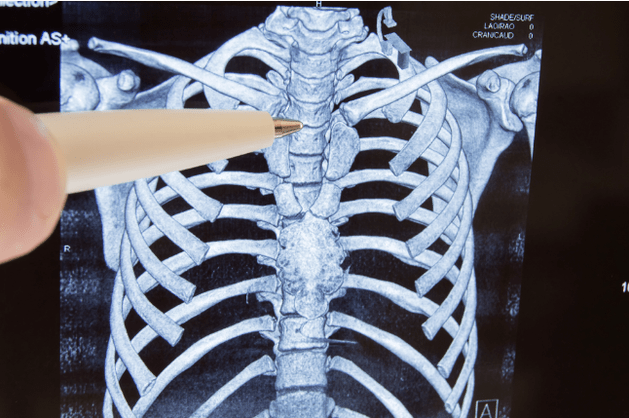Osteochondrosis is a spine disease in which intervertebral discs (and subsequently the body of vertebrae, joints and ligaments) lose their normal functioning capacity.

The cause of osteochondrosis is currently considered a set of factors that affect the spine during a person's life.An additional risk of osteochondrosis develops the resulting lesions of the spine spine, as well as interruption of posture.Some patients observe the connection of onset of disease and hypothermia.
In practice, it is customary to consider
- cervical osteochondrosis,
- Thoracic osteochondrosis and
- Lumbar column.
Separately, it should be noted that osteochondrosis is common, characterized by damage to various parts of the column at once.
The most common are cervical and thoracic forms, since it is these spine departments that are subject to the largest loads.
Osteochondrosis symptoms
With osteochondrosis, patients describe symptoms such as:
- Paroxysmal or firing pain in the spine affected by osteochondrosis;
- Increased pain after physical effort as well as in the morning;
- The pain can be given to the neck, arm or leg as well as in the chest;
- Sense of crisis when performing twists.
Osteochondrosis is also characterized by neurological symptoms on the affected side:
- Partial Movement Violations (Paresis);
- Unpleasant sensations in the form of goose bumps, tingling (paresthesia);
- In palpation, the tension of the muscles corresponding to the affected department is determined.
The disease begins and develops gradually, not markedly.
It is necessary to distinguish coronary heart disease osteochondrosis (with coronary heart disease, the occurrence of pain is not associated with physical activity, but is due to collateral factors: cough, prolonged seat).
Treatment
The same symptoms may be signs of various diseases, and the disease may not occur according to the book.Do not try to be treated - consult your doctor.
Osteochondrosis therapy always requires an integrated approach.In treatment, the attention of doctors such as therapist, rheumatologist, neuropathologist and physiotherapist is required.The treatment of spine osteochondrosis depends on the location, the predominant symptoms and the severity of the disease.
Conservative therapy aims to eliminate the symptoms of pain and restore the normal function of the spine.
Rational nutrition for osteochondrosis greatly facilitates the patient's condition and promotes more effective therapy.Read more about the principles of nutrition for osteochondrosis in our separate article.
About 10% of patients are sent for surgical treatment.The absolute indicator for surgical intervention in osteochondrosis is the appearance of neurological disorders due to the pinch of the spinal cord itself.
Additional indicators for osteochondrosis surgical treatment are considered as follows:
- prolonged periodic attacks of pain;
- increased mobility and suspected instability in the spine;
- ineffectiveness of drug therapy for 3 months;
- Pronounced disorders that prevent the patient from leading a complete life.
Surgical treatment methods
Surgical interventions with minimum trauma:
- The preparations of enzyme preparations are administered on the intervertebral disc after shooting with the objective of healing the core and the fibrous ring of the disc.
- Puncture nucleotomy - Inter -vertebral disc interrogation to remove part of the poison.
- DESHA DERMAVERATION - A medicine is introduced to the intervertebral disc that blocks the sensitivity of nerve endings.
The remaining methods of surgical treatment of spine osteochondrosis are less soft.These include:
- Total or partial removal of the intervertebral disc or hernia - this operation aims to reduce the symptoms of compression.
- Intervertebral Disc Prostheses - The main task is to correct the affected vertebral segments.
Operating methods for the treatment of spine osteochondrosis provide a forecast for a complete recovery in only 50% of cases.
With the opportune treatment, the prognosis for life is almost always favorable, but the prognosis for working capacity may be different due to several factors.
Osteochondrosis exercises
Exercise 1.
Include your head forward while pressing your forehead with your fingers.Press your fingers closely on the back of the head and whiskey - left, right.The head neutralizes the pressure of the hands and the hands - the pressure of the head.Spend 10 seconds.for each movement.
Exercise 2.
Put the tips on four toes on the forehead against each other, gently press the skin with the entire palm surface and with soft traction movements stretch it for 10-40 seconds.We can do the same stretching in the temple in the longitudinal and transverse direction.Same - in the ear - to stretch it in all directions, especially the wolf.What.You improve blood circulation in areas rich in biologically active points.
Exercise 3.
This type of massage improves blood flow in the jugular veins and brain nutrition improves.You feel exactly, the back are straight.Slowly take your head back, helping with your hand, pressing the chin back and up.You can slowly turn your head a little left and right.Stay in this position for about a minute.For children, 10 seconds are enough.
Exercise 4.
This exercise improves the functioning of the cervical nervous plexus.You feel exactly, the back are straight.Slowly tilt your head forward, trying to touch your chest.Place the fabric fingers on the back of the head, press front and up, lifting the back of the head.It feels like this for about a minute.After 15 minutes, you can repeat.
Exercise 5.
Raise your shoulders, trying to take it to your ears, lowest, free, faster - for 15 seconds.Now, alternately - one shoulder up, the other is low, also 15 seconds.Pull the cervical spine with your palms.






















